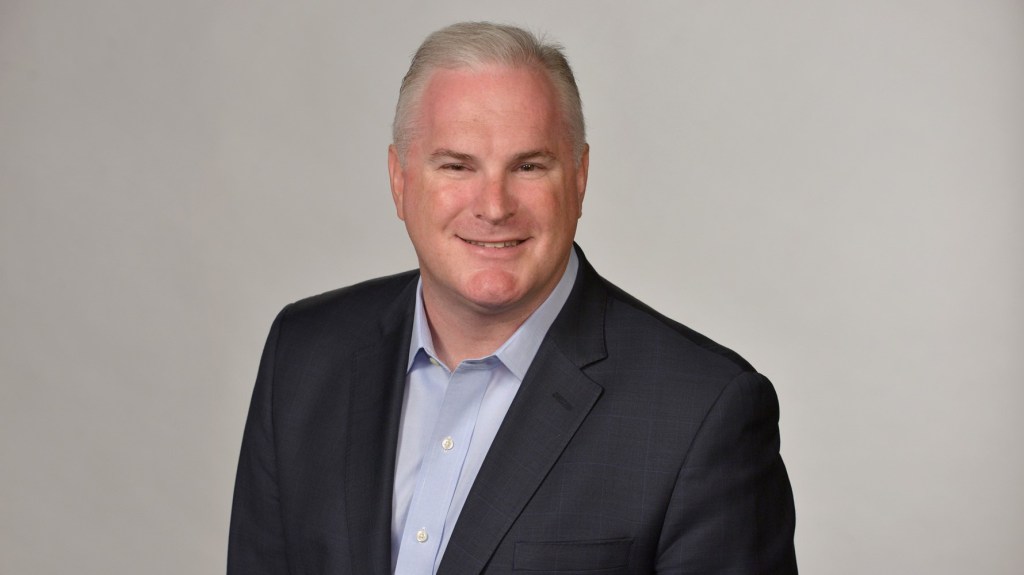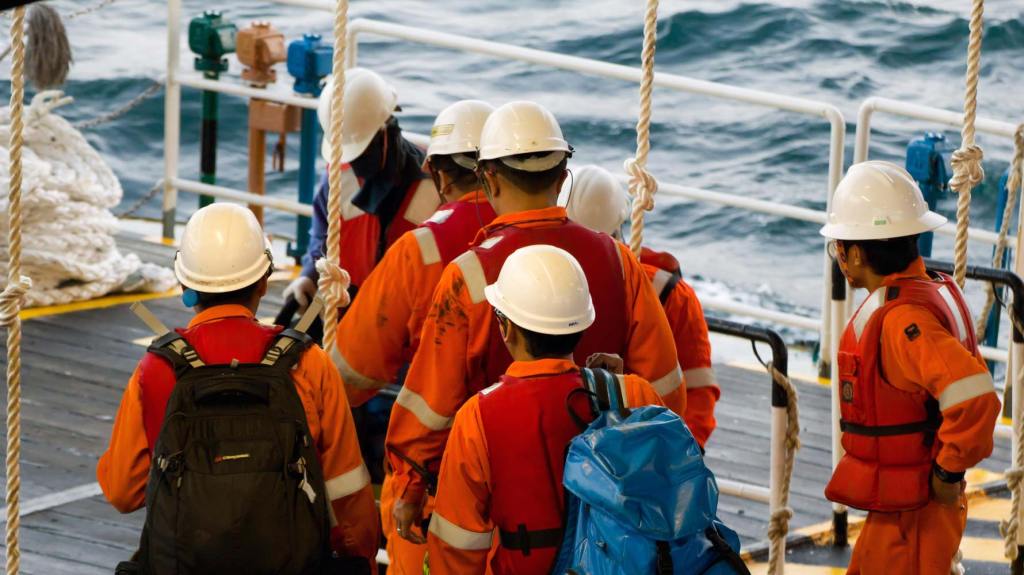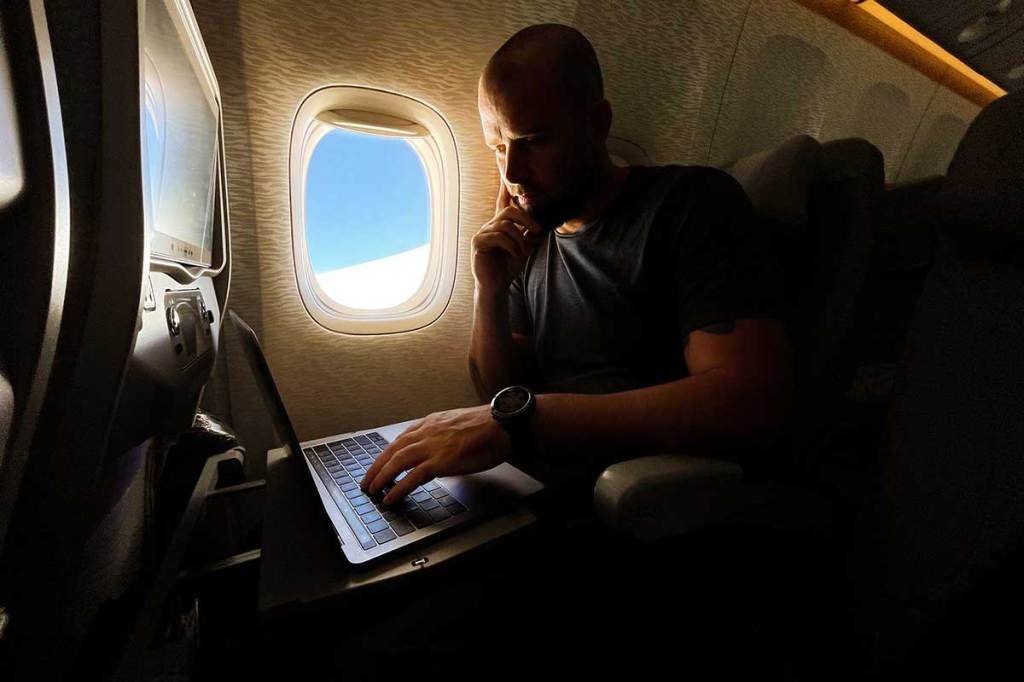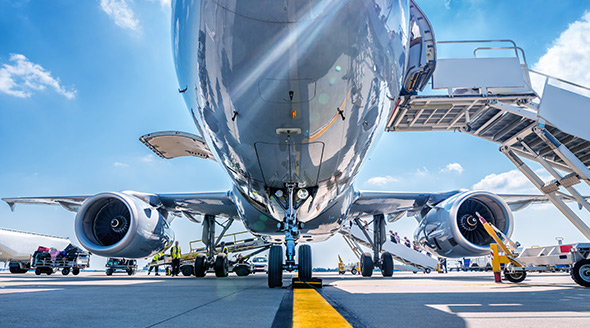Introducing the latest myCWT product and service enhancements
Building on our digital, omnichannel myCWT platform, our new products and services will simplify travel management for you and your employees – anytime, anywhere, anyhow.
Note: Featured services may not be available in your country at this time. Please reach out to your CWT representative for more details.
Hear from Chief Product Officer, Erica Antony as she shares the key product highlights of 2024, along with the key areas driving innovation.
-

2040: Baseline, Boom or Bust
As we enter an era of rapid transformation and unprecedented challenges, it is essential for travel managers, meeting & event planners, and corporate decision-makers to look ahead and frame our current strategic thinking with a clear vision of the future. Business travel and meetings and events (M&E) are poised for significant change over the next decade and a half, driven by a complex interplay of sustainability goals, technological advancements, evolving work models, and geopolitical dynamics.
In this paper to mark the 10th anniversary of our Global Business Travel Forecast, we explore, for the first time, a long-term vision of the future and potential trajectories through three distinct scenarios, each offering insights into how these forces should affect policy-making, budgeting and priorities. By examining these scenarios, we can better understand the diverse possibilities that lie ahead and the strategic imperatives required to thrive in each potential future.
Based on trajectory data analysis and interviews with industry leaders, behaviorists and climate tech founders, this forward-looking approach enables us to anticipate changes, strengthen our strategies, and make informed decisions that align long-term objectives. It is through this lens of foresight and adaptability that we can build resilience, seize opportunities, and navigate the complexities of the future.
We invite you to reflect on the insights presented, and consider how your organization can prepare for the opportunities and challenges that lie ahead. Together we can ensure that travel and meetings remain catalysts for growth, scalability and sustainable practices.
- Scenario development is both an art and a science
- Megatrends Shaping the Future of Business Travel, Meetings and Events
- Sustainability goals the new crux of corporate policy
- Technology Revolutionizes Travel Management
- Modern work models spark new travel patterns
- Changing demographics open doors to new opportunities
- Three Scenarios: Base case, boom and bust
- Future-proofing strategies

-

CWT GBTA Global business travel forecast 2025
When it comes to pricing, global business travel has finally reached an enduring, higher baseline. Prices will continue to rise in 2025, but only moderately, so expect a period of normalized growth.
However, this pricing environment, one of marginal gains and price regularity, is fragile. Global leisure travel has now realized a lot of its pent-up demand, while corporate travel has been resurgent, with 2024 edging at preCovid levels.
There are many factors at play, whether its volatile oil prices, labor costs and constraints, inflationary pressures, and geopolitical factors. As this elevated baseline edges upwards, albeit marginally, travel budgets will come under increased scrutiny, especially as travel patterns and attitudes change.
It’s why business travel can’t be viewed in a silo, and the true value to an organization must be fully realized. This forecast can help with those calculations.

-

Capitalize on emerging technologies in corporate travel
Technological advancements are accelerating at an unprecedented pace. How will emerging innovations like Generative AI, blockchain, and self-sovereign identity (SSI) transform corporate travel?
BTN and CWT probed global CEOs, travel managers, industry consultants and tech experts on the promises, questions, and expectations these innovations raise and how they are set to reshape traveler experience, cost control and service delivery in corporate travel and events.
Download and discover
- The technologies that will have the greatest impact on corporate travel in the next 2-5 years
- How these emerging technologies are poised to control costs, enhance service and security, and boost efficiency
- The critical challenges, opportunities, risks and roadblocks each innovation raises
- What travel managers, buyers and experts anticipate from these innovations

-

Going the distance: 3 tips for essential travel
Sigmund Freud, the founder of psychoanalysis, coined the term ‘Reiseangst’ (from the German, ‘fear of travel’). While we’ve seen a raft of new phrases in the last six months, this one’s ripe for a revival. Even the most seasoned travelers find themselves weighed down with concerns that didn’t exist previously. It’s not surprising. Restrictions on international travel are slowly easing but they remain fluid. Quarantine requirements could change last-minute, there are fewer available routes and the travel experience is a far cry from what it was pre-pandemic. Back then, language barriers, cultural faux-pas, and minor transport delays were our biggest concerns.
Yet, the value of a productive trip remains undisputed, “There’s no real substitute for in-person visits,” says Mike Valkevich, CWT’s VP Customer Management GCG, EMEA, “There’s a continued awareness that business travel is a high return on investment. In most cases, organizations feel or can prove the benefits of face-to-face, including for negotiation or selling, leadership affairs, motivation, and management.”
As some companies temporarily tighten their belts and reduce opportunities to travel, it’s more important than ever that a trip is a fruitful one. Here are three ways to alter your mindset and prepare for a great trip.
- Be prepared
“Anticipate that availability is not what it used to be and be prepared for challenges,” says Valkevich, “As the industry recovers, there will be a need for business travelers to understand that the level of access with lots of available flights and rooms isn’t true anymore. The world of travel has changed considerably.” Knowing that requirements may change, facilities may be reduced or there may be delays, can help to alleviate frustration. - Take a higher level of responsibility
In a survey about the impact of the Covid-19 pandemic on customers, more than half of the companies surveyed by CWT plan on increasing risk management around travel, including defined travel planning and en-route protocols (77%) and live or near-live tracking mechanisms (72%). While companies are very focused on duty of care, travelers will have to step up individual responsibility to understand what’s required, “In the past we may have been accustomed to having an assistant, travel agent or visa processing company handle everything for us,” says Valkevich, “Nowadays, individuals may be required to bring a recent medical test result in order to enter a country, for example. Don’t rely on others. It’s essential to research and have your paperwork in order.” CWT Travel Essentials allows travelers to check for up-to-date requirements for travel between certain countries. - Focus on the benefits
Once you have prepared the necessary documents and taken precautions like wearing a mask and physical distancing, you have done and are doing all that you can. Resist the urge to let uncertainty deplete your mental gas tank. Set a goal for your trip that’s achievable even if things change.
Humans are social creatures. A business trip can be the catalyst for innovation or the foundation of a critically important sale. Add to that, the untold benefits of a change of scenery to emotional wellbeing and motivation. Some anxiety or confusion is inevitable in these strange times. However, checking simple tasks off your list and shifting your mindset will help you make the most of your travels. Here’s another obscure word: “Fernweh.” Also German in origin, it describes a yearning to get away and travel to a distant place. After long periods at home, many of us can relate.
Image credits: Adobe Stock
- Be prepared
-

The fabric of business travel – A message from Kurt Ekert, President & CEO
Martin Luther King, Jr. said, “The ultimate measure of a man is not where he stands in the moments of comfort, but where he stands at times of challenge and controversy.” Well, we are certainly in such times.
The pandemic has infected over 30 million people and caused over one million deaths. Economies are stretched to capacity and the social fabric of many societies has frayed and become disjointed. Mental health, wellbeing, the environment, and personal safety have escalated to the top of the agenda for many, and business life has undergone a seismic shift, at least for now, away from traditional office-orientation. We have learned that spending ten hours in front a screen staring into the faces of colleagues and customers is a poor substitute for real engagement.
Against this backdrop, politicians around the world debate whether to let their economies suffer for the sake of public health, or vice versa. In the final quarter of the year, we likely will see more controversy with almost 30 global political elections, providing an opportunity not only for change but also potential unrest and further financial uncertainty – unaided by traditional economic indicators which continue to grapple ineffectively with on-the-ground economic realities.
Amid the dislocation of 2020, there are winners and losers. Online retailers continue to fare well, as do providers of workspace solutions, as more and more companies look to provide for their employees in remote positions. Makers of hand sanitizing products are another winner, as are big box retailers and supermarkets. And of course, suppliers of video conferencing and webinar capabilities have thrived in this changing environment, as have media streaming outlets.
Closer to home in the corporate travel industry, meetings and events, hotel occupancy and global travel have begun to pick up slightly. These are, however, still substantially below pre-COVID levels, while the pace of travel recovery in the US, according to TSA traffic figures, appears to be slowing.
But what of the fabric of business itself?
Despite businesses becoming increasingly digital, personal engagement, relationships, and rapport cannot be replicated without physical presence. Unlike the old fear of being replaced by computers, if working under the pressures of COVID has taught us anything, it has reinforced the need for a human element at the heart of business life. Indeed, the ability to adapt and mold operations to suit the future depends largely on identifying and nurturing the skills needed for the next generation. Businesses that can blend technology with the right people, in the right places, at the right time, will be the winners. As Bill Gates put it, “The first rule of any technology used in a business, is that automation applied to an efficient operation will magnify the efficiency. The second is that automation applied to an inefficient operation will magnify the inefficiency.”
For most of us in the travel and tourism industry, which in 2019 accounted for circa 10% of global GDP and 15% of global employment, times remain tough. Traditional channels have shifted dramatically to accommodate new customer needs, while we ideate on the new formulas for success. As the military strategist, writer and philosopher, Sun Tzu, is quoted, “Victory comes from finding opportunities in problems.” During this period of market uncertainty, executives need to be artful in focusing resources against safety, service delivery, and core operations, while also supporting innovation-led growth. For while investment in innovation is perhaps most obvious at the moment in pharmaceuticals and medical products, it will be the defining ingredient for future success in our sector as well.
Business travel will not end with this pandemic. We will emerge into a new reality of global business, with companies adapting to meet the kaleidoscopic needs of their customers. The route back to business travel normalcy will take time, with reliance in part on a vaccine in circulation and some return to workplaces. Life will go on, and the fittest will once again thrive.
-

It’s time for a sea change in maritime crew wellbeing
Even as the COVID-19 pandemic has poured quicksand into the gears of the global economy, many essential workers have continued to go into their workplaces and have been instrumental in keeping the economy running. Amongst these are the seafarers who serve as crew on ships and play a critical role in moving goods and natural resources around the world.
Unfortunately, as governments have sealed borders and imposed travel restrictions, and airlines have dramatically scaled back their operations, there have been many harrowing stories of crew stranded for weeks or even months onboard vessels, at airports and in hotels. In July, the International Transport Workers’ Federation estimated that around 300,000 seafarers are trapped at sea. Meanwhile, the Seafarers Happiness Index, published by The Mission to Seafarers, recorded a drop from 6.30 in Q1 2020 to 6.18 in Q2 2020, as crew have found themselves unable to sign off and return home, while having to cope with enhanced health, safety and security protocols in addition to performing their high stress jobs.
In the travel sector, we have witnessed first-hand the anxiety and emotional turmoil of seafarers trying to get home to their families. At CWT Energy, Resources and Marine, we have been working tirelessly with our clients, airline and hotel partners, and various government agencies around the world to get crew members to work and back home safely. This has involved navigating new visa processes and requirements, as well as stringent entry and quarantine stipulations. We have also helped many clients book charter flights to move people when no commercial flights have been available.
The good news is that things are improving. While in April and May, crew rotations had all but come to a standstill, by June we started seeing an upturn in people being moved onto and off ships. In fact, for one of our clients we observed crew movements in June and July jump significantly higher than the three-year average volume.
During this incredibly challenging period, it has been heartening to companies – even those with competing interests – come together and work towards the betterment of conditions for crew members. For example, in certain instances we have worked collectively with the other travel management companies and their clients to optimize flight capacities and operational costs when booking charter services. More can be done to further this interest by way of closer collaboration between industry peers, leveraging of unique strengths and resources between port and travel agents and other vendors to achieve quicker outcomes that are more robust in challenging situations. Technology must be used effectively to drive better decision making and planning.
If there is a silver lining to this pandemic, it is that it has brought the issue of crew wellbeing to the forefront. It has shone the spotlight on a fragmented maritime industry grappling with legacy challenges and forced it into action. We are seeing a paradigm shift in behavior and perception towards essential workers, and with deeper conversations on this issue we can achieve positive outcomes for seafarers that will last far beyond this crisis.
Image credits: Adobe Stock
-

Traveler Experience & Customer Leadership Team appointments
CWT, the Business-to-Business-for-Employees (B2B4E) travel management platform, today announces the strategic aims and leadership team for its newly created Traveler Experience & Customer business unit.
Headed by President, Traveler Experience & Customer, Niklas Andréen, the newly formed unit has overall responsibility for delivering CWT’s B2B4E experience to its business travel and meetings & events customers and their traveling employees, maintaining CWT’s global customer growth rate, and servicing travelers through their chosen channel – from pre-trip to safe return.
“Our obsession is the customer experience of meeting both the demands of our clients and their travelers. Industry challenges have enabled CWT to redefine the business travel model by combining customer and traveler touchpoints under one leadership,” said Niklas Andréen. “This groundbreaking move provides greater efficiency and client intimacy, and delivers a more consistent service across channels and time zones, unlocking the full value of CWT’s offerings.”
Effective immediately, the core leadership team of the Traveler Experience & Customer unit are as follows:
The newly created Global Sales organization, focused on continuing to grow CWT’s business globally and across key industry verticals, is led by Darren Toohey.
Led by Nick Vournakis, and organized around industry verticals, the Global Customer Management team is responsible for all key global, multinational and national customer relationships, and for expanding these across the full width and breath of CWT´s offering.
The newly created Global Market Management & Development organization is led by Belinda Hindmarsh, and focuses on developing national customers across the world, as well as executing CWT’s strategic market investments including China.
The CWT Meetings & Events business is headed up by Chris Bowen and will continue to serve existing and potential customer needs – whether virtually, or in person.
David Rha continues to lead the Global Customer Solutions team, focused on continuing to deliver an industry-leading 50+ Net Promoter Score rating across pre-sales, client implementation and product upgrades.
Sonia Barriere leads Traveler Experience Operations, with end-to-end global responsibility for all contact centers and their staff servicing the travelers of CWT’s customers.
Anthony Allinson leads the Traveler Experience Transformation team continuing to drive global consistency and the use of next generation technology to ensure greater operational efficiency and service innovation ensuring we are ready for the customer of the future.
CWT is a leading global partner in business travel, meetings, and events. Operating across six continents, we deliver sustainable, tailored solutions that help organizations connect, engage, and thrive in an evolving world. Our myCWT platform integrates advanced technology with human expertise to simplify travel and enhance traveler and attendee experiences. Extensive global coverage, seamless data integration, AI-driven analytics, and carbon-conscious travel tools enable businesses to optimize their travel and meetings programs while delivering measurable value.
With 150 years of industry experience and a deep commitment to partnership, CWT collaborates with clients to shape the future of business travel and events, making them more efficient, responsible, and impactful.
-

Keep the change: Will business travel evolve for the better?
The question facing many global businesses now is how travel will change. 9/11 changed the airline industry, the 2008 recession changed spending mindsets. Change is inevitable, of course.
Pre COVID-19, CWT was looking after enough travelers every day to fill more than 250 Boeing 747s, connecting around 25m people and handling over 100 events. Back then, we were still hugging our colleagues, and wearing a homemade mask to work would have elicited strange looks.
It’s impossible to predict exactly how the economy and behavior will fare once the pandemic subsides. What’s clear is that some of the changes that will stick around will likely be for the better.
We asked Jo Hillman, CWT’s Senior Director Sales, UK & Ireland, how business travel will change, at least in the near future. Here’s what she tells us:
- The human connection has become incredibly important
As reported in the Harvard Business Review and the Journal of Experimental Social Psychology – research shows face-to-face engagements are 34 times more likely to garner positive responses than electronic contact. Having been deprived of it for so long, we value face-to-face more than ever.
Even with the availability of self-booking tools, we’re seeing travelers want the added reassurance of speaking with an expert who can answer their questions and provide guidance. As lockdowns around the world forced our offices to close, we had to adapt and enable our employees to work remotely. To help travel counselors use their home phones to take calls, we extended a system built to meet the varying needs of contact center agents. We established gateways that allowed more than 1,600 employees access to their office desktop securely and supported a significant increase in concurrent VPN connectivity. - Duty of care is top of the list of priorities
Companies are looking at making changes to travel policies such as pre-trip approvals, so they can have greater visibility and control over employee travel. We’re helping our customers ensure their employees book through the correct channels and secure all the necessary internal approvals before traveling. Using our safety and security tools, clients can easily locate their traveling employees and assist them in making alternative travel arrangements if required. We’re finding that pre-trip approval processes go a long way to boosting confidence among travelers, too. - Travelers are seeking a lot more information prior to traveling
We’re looking at new technologies to offer information at the point of sale to help travelers make informed decisions around issues like entry requirements, quarantine restrictions, and even the last time a hotel was cleaned. CWT also partners with organizations like International SOS to send our clients and their employees regular alerts about developments on the ground. There’s a great deal of conjecture out there. Companies should communicate regularly with their traveling workforce and offer simple resources from reputable sources.
The day will come when international travel is a less convoluted process than it is today. When it does, valuing human connection, safety, and reputable information can only be positive lasting legacies.
Listen to Concur’s latest webinar to hear Jo Hillman speak about the future of business travel.
Image credits: Adobe Stock
- The human connection has become incredibly important
-

Commercial & RoomIt Leadership Team appointments
CWT, the Business-to-Business-for-Employees (B2B4E) travel management platform, today announces the strategic aims and leadership team for its newly created Commercial & RoomIt business unit.
Headed by President, Commercial & RoomIt, Patrick Andersen, the newly formed unit will maintain the continued growth of CWT’s innovative hotel and business travel offering, optimize product potential for customers and travelers, and maximize the joint potential from supplier partnerships.
“We have the clearest possible mandate to deliver above and beyond our B2B4E proposition, with a compelling and competitive proposition for our customers, their travelers and our partners,” said Patrick Andersen. “I have an extremely strong group of leaders to help us deliver our promise, and I’m delighted to move forward together to help maximize CWT’s true potential.”
Effective immediately, the core leadership team of the Commercial & RoomIt unit are as follows:
The strategy and marketing of CWT products and CWT’s overall business proposition is led by Erica Antony.
Vince Chirico continues to lead and maximize Commercial & RoomIt’s potential from CWT supply chain partnerships, and, under innovation, assumes responsibility for bringing in new partners to the CWT platform.
All trade air, ground and hotel supplier relationships and partnerships will be consolidated under the leadership of Brian Mogler, along with CWT’s travel management, data and air solutions proposition.
Derek Sharp assumes responsibility for the ongoing development and enhancement of RoomIt, CWT’s specialist hotel distribution business, and CWT’s hotel solutions proposition.
External market communications and brand management, including brand development, industry events and sponsorships, is led by Julian Walker.
CWT is a leading global partner in business travel, meetings, and events. Operating across six continents, we deliver sustainable, tailored solutions that help organizations connect, engage, and thrive in an evolving world. Our myCWT platform integrates advanced technology with human expertise to simplify travel and enhance traveler and attendee experiences. Extensive global coverage, seamless data integration, AI-driven analytics, and carbon-conscious travel tools enable businesses to optimize their travel and meetings programs while delivering measurable value.
With 150 years of industry experience and a deep commitment to partnership, CWT collaborates with clients to shape the future of business travel and events, making them more efficient, responsible, and impactful.
-

Armchair traveler: 3 ways to reap the benefits of travel, from home
When you have a busy travel schedule, you never know who you might meet, what connections you might make, or what new opportunities await. There’s a reason why a study by Oxford Economics reveals that for every dollar invested in business travel, companies realize $12.50 in incremental value.
If you get bored doing the same thing every day, business travel can keep life interesting and give you new perspectives and ideas. However, due to temporary local lockdowns and some companies reducing the number of trips that staff can take, the myriad benefits of travel aren’t always within easy reach. Here’s how to improvise in between trips.
- Sign up to relevant webinars, virtual events, and podcasts
In lieu of chance encounters at a live networking event, many events that were previously reserved for paid attendees are being offered free. Find events with speakers that are aligned with your career goals. The bonus of remote events is that you can listen to webinars and podcasts while washing the dishes, and network virtually when you’re back at your desk. - Be proactive about asking for connections
Take advantage of this moment in time when sought after people are generally more accessible because they’re spending less time in transit or on flights. They’re likely to be more open to taking a call or agreeing to a video interview than before the Covid-19 pandemic. - Use your downtime to plan a spectacular trip
The biggest reason why business travel is critical is to foster personal interactions. Face-to-face meetings can increase understanding, reduce miscommunication, and inspire creativity. If you’re taking fewer trips or still awaiting your first after a long lockdown, use your time to design an extra inspiring agenda or presentation.
Download our travel checklist and check for restrictions, leaving you free to focus on the fun part. One thing is for sure: We won’t take the benefits of travel for granted again.
Image credits: Adobe Stock
- Sign up to relevant webinars, virtual events, and podcasts
-

Half and half: How to transition from a remote to hybrid workplace
Half and half means different things to different people. In Denmark, it’s a mixture of dark beer and pilsner. In the United States, it’s a light cream that’s not quite as fun as the full-fat version but necessary for your health, akin to the workplace arrangements at many companies these days.
Around the world, organizations are embracing some version of ‘half and half.’ Some employees are returning to their desks, others will stay working from home, and some will move to a hybrid arrangement, swapping days with their colleagues to reduce the number of staff on site at any one time. It’s a healthier, slimline approach to life at the office. Here’s how to make the transition from fully remote to hybrid, a smooth one.
- Time is of the essence – “The key is in not spending time, but in investing it,” says productivity guru Stephen R. Covey. As the morning commute morph from a short walk to the living room to a labyrinth of arrows, masks and sanitation stations, time will become more precious for those going into the office. Keep calls as short as possible and set an agenda or goal before each one.
- Out of sight, still in mind – “Be transparent, open clear channels of communication and, listen with empathy and respond honestly,” says Catherine Maguire-Vielle, CWT’s Chief HR Officer. If you make a decision or communicate information to colleagues at the office, follow up with an email to your remote workers to keep them in the loop.
- Bridge the gap – During a time of great uncertainty and change, now is the time to look after your people, at home as much as at the office. CWT’s working from home charter helps employees stay motivated and connected.
- The social network – According to Gallup’s meta-analysis, companies with an engaged workforce are 21% more profitable. As some of your team go into the office, don’t dispense of virtual drinks or online chat groups. Staying connected and sociable virtually is just as important, if not more, for hybrid teams. CWT hosts regular all-employee townhalls with staff in over 40 countries. Employees can dial in wherever they are.
- Re-evaluate your culture – There are regional and national differences to bringing people back to the office. How do you build the right culture with a sporadic, distributed workforce?
Leading organizations will look at how work should be done and the role of the office. There is no one-size-fits-all solution. Businesses can use this moment to reinvent their culture, improve collaboration and productivity, and create an opportunity for improved innovation.
Image credits: Adobe Stock
- Time is of the essence – “The key is in not spending time, but in investing it,” says productivity guru Stephen R. Covey. As the morning commute morph from a short walk to the living room to a labyrinth of arrows, masks and sanitation stations, time will become more precious for those going into the office. Keep calls as short as possible and set an agenda or goal before each one.
-

CWT Solutions Group creates new responsible travel consulting framework to help companies build more balanced travel programs
CWT Solutions Group, the consulting arm of CWT , the B2B4E travel management platform, has created a new responsible travel consulting framework to help companies look beyond compliance and cost management, and build more balanced travel programs that also align with other important objectives.
Using its new ECO framework – short for Employee Wellbeing, Climate Impact and Organizational Performance – CWT Solutions Group guides organizations in designing travel programs that advance their triple bottom line. With this approach, business travel becomes an avenue through which companies can simultaneously create an engage d and motivated workforce, reduce their environmental impact, and manage costs more effectively.
“With our new ECO framework, we’re layering employee wellbeing and environmental considerations onto our suite of consulting services which have traditionally focused on objectives like increasing compliance and lowering costs,” Richard Johnson, Senior Director, CWT Solutions Group. “Our aim is to help companies find the sweet spot between these different and sometimes conflicting priorities in their travel programs – and we’re providing them with a roadmap to get there.”
“The COVID-19 pandemic has further focused customer priorities on employee safety and well- being and, with our ECO approach, we are offering them a clear and structured way to do this,” said Françoise Grumberg, Vice President, Global Responsible Business and Diversity & Inclusion, CWT.
In addition to developing proprietary tools to assess and improve the performance of travel programs with respect to employee well-being and environmental impact, CWT Solutions Group has partnered with Atmosfair, an independent non-profit organization specialized in making business travel greener, on a highly accurate and granular methodology to calculate CO2 emissions.
By applying the ECO framework to its existing consulting services, CWT Solutions Group has created an end-to-end responsible travel consulting program that covers five areas:
- Strategic assessment: Understanding the current status of the company’s travel program and its organizational objectives. This is followed by setting goals and targets, and defining a strategy to achieve them.
- Travel policy review: Aligning the company’s travel policy to its responsible travel goals. CWT Solutions Group has created a tool that lets an organization assess how its travel policy lines up with the three ECO pillars, as well as benchmark it against other companies’ travel policies.
- Supplier sourcing & management: Incorporating responsible travel criteria into the request for proposal (RFP) process across all travel categories, and conducting ongoing contract reviews with suppliers.
- Change management: Bringing stakeholders across the organization on-board with changes to the travel program through targeted communications, education sessions and workshops.
- Reporting & insights: Defining key performance indicators (KPIs) for the travel program, and providing data, insights and reporting on these metrics. This includes benchmarking performance against industry peers and using predictive analysis to forecast outcomes.
Having piloted the ECO framework with a small group of clients and received extremely positive feedback, CWT Solutions Group is embedding this approach into its global consulting offer.
CWT is a leading global partner in business travel, meetings, and events. Operating across six continents, we deliver sustainable, tailored solutions that help organizations connect, engage, and thrive in an evolving world. Our myCWT platform integrates advanced technology with human expertise to simplify travel and enhance traveler and attendee experiences. Extensive global coverage, seamless data integration, AI-driven analytics, and carbon-conscious travel tools enable businesses to optimize their travel and meetings programs while delivering measurable value.
With 150 years of industry experience and a deep commitment to partnership, CWT collaborates with clients to shape the future of business travel and events, making them more efficient, responsible, and impactful.
CWT Solutions Group
CWT Solutions Group drives value and growth to its clients’ businesses by helping them to extract more value from their travel and expense program through state-of-the-art technology and business travel knowhow. Its innovative approach focuses in four key areas to achieve true ROI: travel and expense strategy, data insights, supplier management, and travel services outsourcing. CWT Solutions Group is the consultancy arm of CWT, the B2B4E travel management platform. -

Strategy & Transformation Leadership Team appointments
CWT, the Business-to-Business-for-Employees (B2B4E) travel management platform, today announces the leadership team and strategic priorities for its newly created Strategy & Transformation business unit.
Headed by President, Strategy & Transformation and CFO, Michelle McKinney Frymire, the newly formed unit will ensure that the company delivers all transformation initiatives, drives technology innovation, and further enhances CWT’s performance-based culture.
“It’s a privilege to lead this talented team, who are committed to delivering exceptional service as well as industry leading technologies and innovation,” said Michelle McKinney Frymire. “This new structure and approach, delivered by an amazing group of leaders, will drive agile decision making, increase alignment with our strategic goals, and accelerate our growth and transformation.”
Effective immediately, the core leadership team of the Strategy & Transformation operating unit are as follows:
HR, Talent and Performance, led by Chief Human Resource Officer Catherine Maguire-Vielle, will ensure we continue to be a destination of choice for a diverse, driven and creative workforce. Catherine and her team will continue to lead all of the company’s HR, payroll, internal communications, responsible business and culture functions, and Catherine continues to serve on CWT’s Executive Leadership Team.
John Pelant continues as Chief Technology Officer and is responsible for identifying and delivering on the company’s technology operations and investments. John and his team of talented professionals will continue to drive industry leading technologies, services, and solutions. John continues to serve on CWT’s Executive Leadership Team.
The newly formed Strategy, Planning & Analytics group is headed up by Julia Kou and has responsibility for ensuring our investments and priorities are continuously aligned with CWT’s strategic plan, and oversees the company’s corporate planning, pricing and profitability functions.
Courtney Mattson is appointed Global Treasurer and Deputy CFO and ensures that CWT continues to deliver on effective balance sheet and financial operations management, to maintain a strong financial foundation for meeting our commitments to our customers and suppliers.
CWT is a leading global partner in business travel, meetings, and events. Operating across six continents, we deliver sustainable, tailored solutions that help organizations connect, engage, and thrive in an evolving world. Our myCWT platform integrates advanced technology with human expertise to simplify travel and enhance traveler and attendee experiences. Extensive global coverage, seamless data integration, AI-driven analytics, and carbon-conscious travel tools enable businesses to optimize their travel and meetings programs while delivering measurable value.
With 150 years of industry experience and a deep commitment to partnership, CWT collaborates with clients to shape the future of business travel and events, making them more efficient, responsible, and impactful.
-

Meeting expectations: 5 things Australian planners should consider as meetings & events resume
Between the devastating bushfires and the coronavirus pandemic, it has been a difficult year for meetings and events in Australia so far. Companies have had to adapt by moving some meetings online – but virtual interactions aren’t a perfect substitute for face-to-face meetings. It’s harder to sustain people’s attention and form meaningful connections in a virtual setting or make employees feel valued and motivated in a way that can be achieved through an incentive trip.
Even as Australia and the rest of the world continues to grapple with the effects of the virus, our industry is slowly beginning the long and challenging road to recovery. In Australia, both indoor and outdoor events have been allowed to restart since July, albeit with various restrictions around capacity and safe distancing. Just this past week, all of the country’s states and territories, with the exception of Western Australia (WA), agreed to develop a roadmap to reopen domestic borders by Christmas. Of course, the situation remains quite fluid and restrictions are changing daily – as we have recently seen in parts of Victoria and NSW – and so there remains a sense of caution.
At CWT Meetings & Events, we are seeing positivity amongst our clients in Australia and New Zealand, with corporates starting to make domestic event inquiries and arrangements for Q4 2020 as restrictions ease. Companies are rethinking their meeting strategies for the last quarter of this year and for next year, to ensure they’re able to secure the venues and accommodation of their choice.
Naturally, a lot will be different for meetings and events post-COVID-19 – at least in the near- to mid-term. Safety is the top priority, so we will likely have more local and domestic events, with health screenings and stricter hygiene protocols at venues. Group sizes are likely to be smaller, with digital channels being used to reach wider audiences.
Here are some of the important considerations that companies should think about as they look to resume their meetings and events:
1. Destinations– While international destinations had previously been favoured over remote regions in Australia, given the similar overall costs, this is changing due to the prevailing uncertainty around international travel. Corporates are now looking at taking their events to some of those bucket-list Australian destinations like Broome, the Northern Territory, and the Whitsundays. They are keen on exploring domestic options both to support in the recovery of the local economy, as well as to provide a safe avenue for delegates to reconvene.
Earlier this year, Tourism Australia kicked off its “Holiday Here This Year” campaign, encouraging Australians to get out and see their own backyard. As part of this initiative, Tourism Australia and various state tourism boards are offering incentives for organizing domestic meetings and events, and this is something we’re actively looking into on behalf of our clients.
2. Getting there– Picking a unique and exciting destination is well and good, but you also need to get your attendees there in a way that’s comfortable, cost-effective and most importantly, safe.
One of the options we’ve been looking into with our clients is to have staggered itineraries that limit the amount of people on one aircraft. We have also been working closely with our airline partners to discuss the possibility of safe-distancing on flights for group travel bookings, as well as chartering flights where appropriate.
For incentive trips, planners can consider unique modes of transportation, such as luxury rail journeys, that become part of the experience. A one-night stop somewhere interesting en route, or multi-destination itineraries, may be more prevalent to drive incentive engagement.
For all events, pre-event communications with safety reminders for attendees should become a must-have.
3. Venues– There’s no shortage of spectacular venues in Australia, offering world-class facilities and dining options with the most breathtaking scenery. We’re having regular conversations with our accommodation and venue partners to understand what measures they are putting in place to address concerns around attendee safety.
These include: the exclusive use of properties or wings/sections of hotels; pre-booked elevator times, controlled by hotel staff for event guests; and the appropriate personal protective equipment and sanitization where necessary.
4. Format– Even as meetings and events start up again, not all attendees may be able to be physically present at the venue due to safe-distancing requirement and travel restrictions. We will likely see more hybrid events that combine both virtual concepts and live events to reach a wider audience.
People often think that the “virtual” element of a hybrid meeting simply means using Zoom or Webex to broadcast the discussions taking place at the venue to the remote attendees. If you really want to engage your virtual event audience and promote connectivity, there’s a lot more to consider. For instance, in live events there is often some buffer time between sessions and attendees can chat to the person next to them. With hybrid events, you can’t have dead-air in the virtual portion – the online audience needs to be engaged from start to finish, and so greater time restraints apply.
Time management will get trickier. Breaks may need to be longer to allow for social distancing and other safety measures, so planners should consider building extra buffer time in their sessions to account for this. Breakfasts could be moved into the meeting room to ensure the event starts on time, whilst still fulfilling all necessary safety precautions.
With fewer flight options available, clients might look to add some extra activities to fill time.
And with incentives, planners will be forced to create bespoke experiences more than ever before. This could mean engaging with producers from regional areas to come up with event concepts that may not have been done in the past.
5. F&B –Buffets, while an efficient way to feed large amounts of people quickly, will likely disappear due to hygiene and safe-distancing concerns. Instead, individual lunch boxes for meeting breaks may get a facelift with the right attention.
I’ve also found that event attendees love live stations and I believe these will stay, albeit with greater attention to safety – for example, without self-service.
Without a doubt, the return to live meetings and events will be challenging as we are forced to contend with questions and unknowns that we would never even have considered a few months ago. But if all stakeholders work together – including agencies, planners, airlines, airports, hotels, and governments – I’m confident that there is no obstacle we can’t overcome as we work to create safe and memorable experiences for attendees. We are so fortunate to have some of the world’s most beautiful destinations on our doorstep and we are ready to showcase what Australia can offer more than ever before.
A version of this article was first published on Spice News and is republished with permission.
Image credits: Adobe Stock
-

Podcast: Talking On Air: Managing your air program in an uncertain world
As businesses reconnect and travel restarts, questions remain over how to design an air program fit for an uncertain and changing world. During this podcast, Delta Air Lines and Air France-KLM look to address some of the key issues for travel managers, including: 2021 RFPs, unused tickets, boosting employee confidence and safety concerns.
[buzzsprout episode=’5363809′ player=’true’]